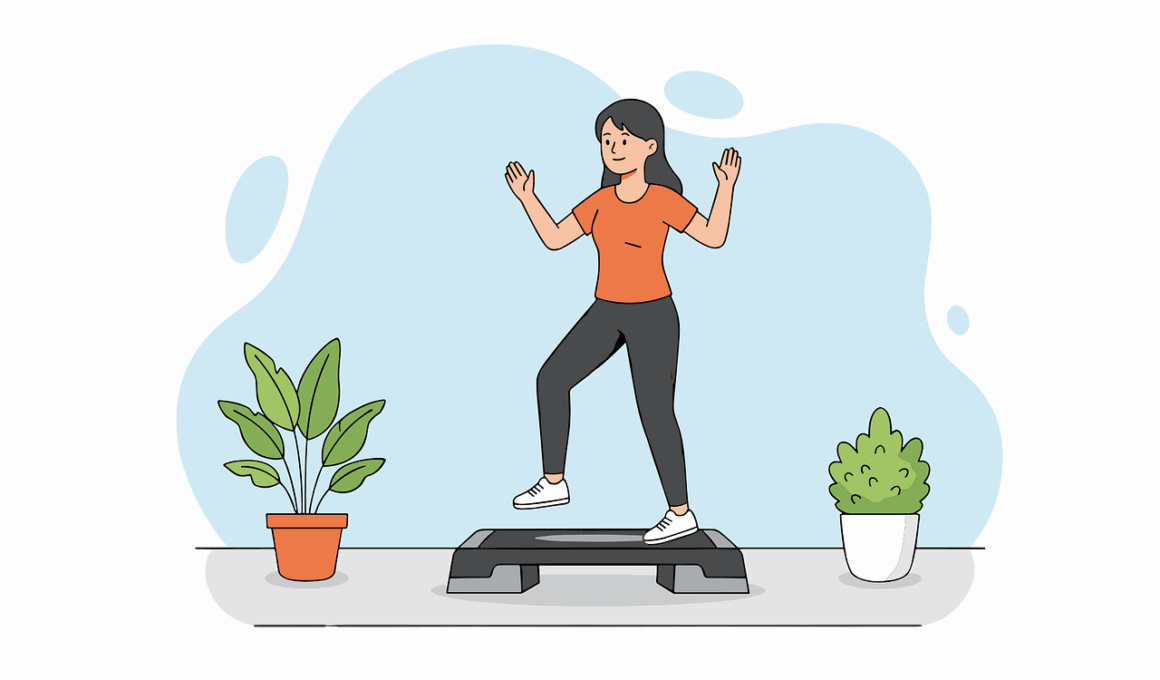Using Resistance Bands in Senior Low-Impact Aerobics
Low-impact aerobics is an ideal exercise option for seniors, focusing on enhancing mobility and overall health. One effective way to enhance these workouts is by incorporating resistance bands. These bands offer excellent versatility, allowing for a wide range of exercises that can adapt to various fitness levels. They help improve strength, endurance, and flexibility. Additionally, resistance bands can be easily used at home or in a group setting, making them accessible to many seniors. Unlike traditional weights, bands provide a unique type of resistance that promotes safer, low-impact exercises tailored for older adults. It’s important to choose bands of appropriate resistance, ensuring safety and effectiveness. Incorporating bands into regular routines not only increases the challenge but also keeps exercises interesting. Seniors can particularly benefit from the added resistance without the risk of injury that heavier weights can pose. Remember, before beginning any new exercise regime, especially with bands, it’s advisable to consult a healthcare professional. This is to ensure exercises are suitable for individual health conditions, ultimately leading to better results and more enjoyable experiences in senior fitness.
Benefits of Resistance Bands
The many benefits of using resistance bands for seniors are impressive and crucial. Firstly, they are lightweight and portable, making them easy to store and transport. This means they can be utilized in various environments, including home workouts or community centers. Secondly, resistance bands are particularly safe for seniors, as they do not place excessive strain on joints, which can be an issue with heavier weights. By using bands, seniors can still engage their muscles effectively while minimizing the risk of injury. Moreover, bands help improve functional strength, which is vital for daily activities like walking, climbing stairs, or lifting groceries. They also provide varying resistance levels, accommodating seniors with different strength capacities. This adaptability allows seniors to gradually increase the intensity of their workouts as they grow stronger and more confident. Additionally, resistance bands are cost-effective, often making them an ideal solution for seniors on a budget who want to maintain their fitness. Overall, including resistance bands in workout routines can lead to significant improvements in strength, mobility, and overall quality of life for seniors.
Another significant aspect of resistance bands is their role in promoting group fitness activities. Engaging in social workouts can provide a sense of community and camaraderie among seniors. Group fitness classes utilizing resistance bands can motivate individuals to participate consistently and stay accountable. Exercising with others can also foster friendships and reduce feelings of isolation, which is crucial for mental health. Furthermore, instructors can guide seniors on proper techniques, ensuring safer workouts. This guidance helps prevent injuries commonly seen with incorrect form, especially in older adults. Incorporating games or team challenges using resistance bands can elevate these sessions, adding an element of fun while encouraging physical activity. Another advantage is the endless variety of exercises that can be performed with bands, from squats to arm curls. The creativity involved keeps workouts fresh and exciting, which is important in maintaining engagement in fitness routines. Overall, the incorporation of resistance bands in group settings enhances the social aspect of exercise while ensuring a beneficial workout experience for senior participants.
Simple Resistance Band Exercises for Seniors
To get started, here are some recommended resistance band exercises that are ideal for seniors. Firstly, seated row is excellent for strengthening back muscles, which supports good posture. To perform this, secure the band at the feet while seated, grasping the ends and gently pulling them towards the torso, while keeping elbows close to the body. Secondly, the chest press can help tone the upper body. Anchor the band behind you, hold the ends, and press forward while maintaining a straight back. Third, standing leg lifts, enthusiastic yet gentle, target lower body strength. Simply stand on the band and lift one leg sideways, one side at a time. Lastly, arm curls help in toning the arms. Stand on the band with both feet, holding the ends, and curl the arms upward while keeping elbows stationary. These exercises enhance muscle strength and improve coordination without straining the joints. Always remember to start with limited resistance and gradually increase as strength and comfort improve. This incremental approach leads to better development and successful exercise practices.
Incorporating proper techniques during resistance band exercises is essential to maximize benefits and minimize risks. To ensure effectiveness, seniors should first warm up to prepare the muscles and reduce the chance of injury. A simple warm-up can include gentle stretching or brisk walking for a few minutes. Focusing on slow and controlled movements during exercises ensures better muscle engagement and less risk of injury compared to fast motions. Additionally, maintaining good posture is crucial; seniors should keep their back straight and core engaged during exercises to provide stability. It’s also important to utilize the bands correctly, ensuring they are anchored properly and free from damage. Using bands that are too thick can lead to overstraining, while very thin bands may not provide adequate resistance. Seniors should listen to their bodies, resting as needed, and avoiding any activity that causes discomfort or pain. Set realistic goals tailored to individual capabilities, ensuring that fitness remains an enjoyable journey rather than a challenge. Building a routine around these principles can greatly enhance the effectiveness of resistance band training for seniors.
Staying Motivated with Resistance Band Workouts
Staying motivated during fitness routines is vital for seniors, and resistance band workouts can be particularly engaging. Setting specific, achievable goals can help maintain these motivations, creating a sense of accomplishment with each milestone reached. Group classes or virtual challenges can also enhance motivation, as participants encourage one another and celebrate progress together. Scheduling regular workouts provides structure, making exercise a habitual part of life. Additionally, varying workouts can keep things fresh and exciting. Incorporate different exercises, change the order of routines, or introduce new bands with different resistance levels to maintain enthusiasm. Participating in workshops or classes focused on resistance band training can inspire new techniques and create excitement about fitness. Another excellent idea is to track progress visually; seniors could keep a journal or use an app to record improvements in strength or overall health. This visibility often keeps motivation high as they can directly see their accomplishments. Remember that celebrating small successes, whether it’s improved endurance or successfully completing repetitions, contributes positively toward a senior’s fitness journey with resistance bands.
Lastly, safety should always be a priority when using resistance bands during workouts. As seniors age, the risk of injury can increase, so it’s vital to ensure all exercises are performed in a safe environment. Always check resistance bands for signs of wear and tear, as a broken band can lead to unexpected injuries. Additionally, using secure anchor points or avoiding slippery floor surfaces can reduce the risk of accidents. Wearing proper footwear with good traction also helps maintain stability while exercising. Planning workouts around personal limits is essential; seniors must avoid pushing themselves too hard, as this can lead to exhaustion or injury. Consider enlisting the assistance of a physical therapist or qualified trainer to ensure exercises are appropriate and modifications are made when necessary. Encouraging seniors to have an exercise buddy can provide added safety; they can assist in workouts, ensure proper form, and lend support when needed. In conclusion, prioritizing safety will enable seniors to make the most out of their resistance band workouts, leading to beneficial and enjoyable experiences in low-impact aerobics.
In summary, incorporating resistance bands into senior low-impact aerobics offers numerous advantages tailored specifically for older adults. Whether enhancing strength, flexibility, or balance, these bands represent a versatile workout tool that opens up a variety of exercise possibilities. Engaging in regular workouts not only contributes positively to physical health but can also foster social connections and improve mental well-being. By incorporating variety, practicing safety, and focusing on techniques, seniors can enjoy a safe and effective exercise routine that suits their needs. It’s crucial to remember that building a fitness habit takes time and patience, but with the right mindset and tools like resistance bands, anyone at any age can achieve their fitness goals. This gradual journey in fitness can lead to increased confidence, improved health, and a greater sense of accomplishment over time. For seniors interested in enhancing their fitness regime, resistance bands present an excellent, accessible, and safe option that promotes long-term health benefits and enriches life quality.


